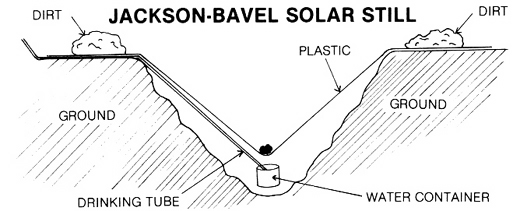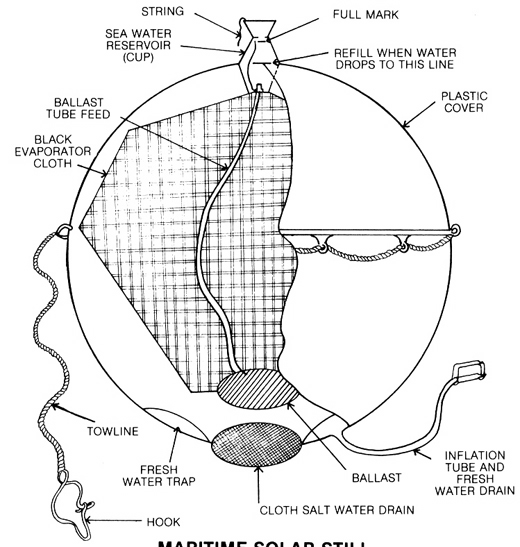Water: the fluid of life and very often a major factor in survival. See Thirst section for additional comments. The usual problem is where to find it. Exceptions are disasters such as nuclear attack where you must have stored and protected water in order to survive. Existing household water reserves are found in the hot water tank, water pipes, and flush tanks (not bowls) of toilets. Surface sources include streams, lakes, ponds, rivers, swamps, pools, potholes, dew, and springs or ground seepages. Study the map and actual terrain to help locate these. Do not overlook high or rocky areas, because depressions, pockets, and clefts in the rock collect rainfall. A well, cistern, or other subsurface sources may also provide the water you need. Look for water just below the surface by digging where the cattails, willow, greasewood, or elderberries grow. Also, dig where you find heavy vegetation along the bank of a dry riverbed, or at the base of rocks and cliffs. You can cut into vines, bamboo, and barrel cactus and usually find water. Cactuses are scarce, so do not use unless you have to. Chew or mash its bad tasting water out of the cactus pulp. Collect dew in the early morning by mopping it up with a cloth and then wringing it into a container. Fresh water can be obtained from salt water, vegetation, and soil by use of the Jackson-Bavel solar still. Dig a hole in the ground about 3 feet deep and 3 feet across. Fill the bottom 8 inches of the hole with vegetation or salt water if available. If not, you can obtain water directly from the soil. Place a water container in the bottom center of the hole. Improvise if you do not have one. A cup made from bamboo will do. Run a hollow reed from the container to the side of the hole and two feet beyond. Cover with a 6 x 6 foot sheet of clear plastic taken from your survival kit. lf you do not have one, you will have to search for other sources of water. Center the plastic over the hole and place a fistsize rock in the center of the sheet. Let the plastic slip into the hole until it is about four inches above the container. Then seal the plastic around the edges of the hole. Rocks and dirt will serve this purpose. The sun will then cook the water vapor out of the ground, vegetation, and/or salt water. This will condense and drip down the inside of the plastic into the water container. See the drawing below. Under most circumstances, one still will produce enough water to meet the daily requirements of one man. But, two such stills may be needed in very arid deserts. Dig new still holes, or add new vegetation or salt water on a daily basis vival.
See Thirst section for additional comments. The usual problem is where to find it. Exceptions are disasters such as nuclear attack where you must have stored and protected water in order to survive. Existing household water reserves are found in the hot water tank, water pipes, and flush tanks (not bowls) of toilets. Surface sources include streams, lakes, ponds, rivers, swamps, pools, potholes, dew, and springs or ground seepages.
Study the map and actual terrain to help locate these. Do not overlook high or rocky areas, because depressions, pockets, and clefts in the rock collect rainfall. A well, cistern, or other subsurface sources may also provide the water you need. Look for water just below the surface by digging where the cattails, willow, greasewood, or elderberries grow. Also, dig where you find heavy vegetation along the bank of a dry riverbed, or at the base of rocks and cliffs. You can cut into vines, bamboo, and barrel cactus and usually find water. Cactuses are scarce, so do not use unless you have to. Chew or mash its bad tasting water out of the cactus pulp. Collect dew in the early morning by mopping it up with a cloth and then wringing it into a container. Fresh water can be obtained from salt water, vegetation, and soil by use of the Jackson-Bavel.

At sea, the typical dinghy or life raft should be equipped with a Maritime Solar Still. It is an orally inflated clear plastic ball that contains an internal ball made of black evaporator (felt) cloth. Supplemental parts of this still are detailed in the drawing that follows. To operate, first saturate the salt water drain in the sea. Inflate until firm. Attach the still to your raft using a towline. Fill the salt water reservoir and then release the still to float on the sea. Salt water will flow through the black cloth where the water can be evaporated by heat from the sun’s rays. This fresh water vapor condenses on the cooler walls of the outer plastic ball. Water drops are formed and run down in to a fresh water trap. Remove fresh water at least three times daily and refill the salt water reservoir at the same time. With adequate sunlight, the normal daily yield per still is one quart of fresh water. Discard the first 2-hour putout to prevent possible sickness from chemical preservatives used inside the Maritime Still. It should be noted that the cloth salt water drain allows excess air to escape thus preventing overinflation from heat expansion or too much air. Condensed water vapor will cause the plastlc ball to be silvery in appearance. If it does not look silvery when in operation, pull the reservoir string which is designed to clear the salt water feed of foreign matter.
MARITIME SOLAR STILL
